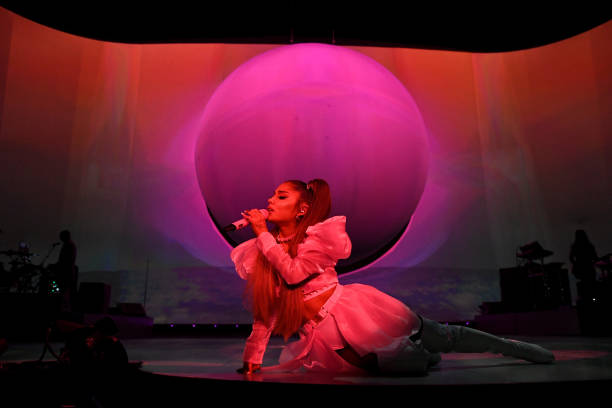Very few people experience heartbreak as publicly as Ariana Grande.
A ubiquitous pop culture figure since her teenage years, Grande hit a new zenith with 2018’s “thank u, next,” a spectacular pop song doubling as a candid document of personal tumult. Written in the wake of a concert bombing, the accidental death-by-overdose of ex-boyfriend (and celebrated rapper) Mac Miller, and a volatile separation from former fiancé Pete Davidson of NBC’s Saturday Night Live, “thank u, next” — Grande’s first number one single in America — contextualizes her struggles so that they aren’t struggles at all, merely steps in her personal growth. Whether a product of her healing or a part of its process, the song approaches heartbreak with a tenderness that runs counter to its moment in history, when society’s gradual relocation to the internet normalized fast judgments and anonymous hostility. While breakup songs tend to be justifications for unfettered vitriol, even if that vitriol needs no justification, “thank u, next” is a rarity: a championing of self-empowerment without a hint of scorn.
The child of a CEO and a graphic designer, Grande entered the public eye in 2008 at age 15, when she won the role of cheerleader Charlotte in 13, the first Broadway musical with a cast and orchestra composed entirely of teenagers. She rose to mainstream fame for her role as Cat Valentine in the Nickelodeon-produced sitcom Victorious, which ran for four seasons between 2010 and 2013. By the end of the show’s first season, Grande began to prioritize a musical career, working with a vocal coach to hone her four-octave range. Like many teen idols of the era, she took advantage of YouTube’s democratizing platform to showcase covers of songs by her biggest influences, melisma masters Whitney Houston and Mariah Carey; Monte Lipman, CEO of Republic Records, eventually discovered these videos and signed Grande to the label.
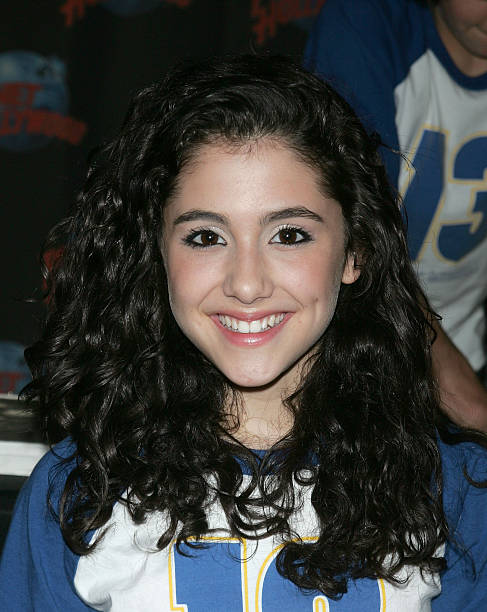
Over the next few years, Grande oscillated between Nickelodeon’s orbit and the pull of her own musical aspirations, and in 2013, two months after the cable network aired the pilot episode of the Victorious spinoff Sam and Cat, she released her full-length debut Yours Truly. Thanks to her Nickelodeon fame, the album immediately topped the Billboard 200, its commercial success earning her multiple American Music Awards, two visits to the White House, and three shows on Justin Bieber’s Believe Tour. Grande found her first critical success with the Max Martin-produced “Problem,” the lead single off of her second album, 2014’s My Everything, and from there, she landed one hit after another: the follow-up singles “Break Free” and “Love Me Harder,” along with her co-credit on Jessie J’s “Bang Bang,” all entered the Billboard Top Ten, and with the 2016 release of her third album, Dangerous Woman, Grande entered adulthood as a performer known primarily for her music, not her TV past.
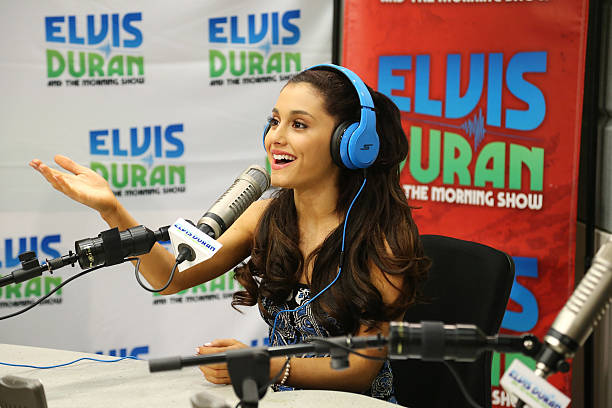
Grande’s ascent coincided with social media’s ivy-like grafting onto American culture. Across the 2010s, platforms like Facebook, Twitter, and Instagram morphed into veritable public utilities, and celebrity culture — the dynamic between highly-visible people and the general public, specifically — was irrevocably transformed. Social media users now had unprecedented, potentially unlimited access to their idols, and their idols held unprecedented power and control over their own public personas. The most successful musical artists of this era took heavy advantage of this new paradigm, and Grande certainly ranks among them. Her status as a teen star allowed her instant recognizability as Nickelodeon’s core tween audience aged into social media, yet her accessibility as a public figure in young adulthood — from her “age-appropriate” fashion sense to her consistent lyrical focus on self-empowerment to her diplomatic nature (an image she and her team took great care in maintaining) — won support from audiences across all ages and backgrounds. (Her outspoken support of LGBT rights heavily endeared her to the gay community, for example, while her sartorial sense provided a style blueprint for hundreds of millions of individuals the world over.)
By 2019, Grande had accrued 150 million followers on Instagram and 60 million on Twitter, making her one of the most followed and influential figures on both platforms — a notoriety making certain aspects of life, like coping with tragedy, much more difficult to deal with. Near the end of Grande’s performance at Manchester Arena in 2017, a suicide bombing by a 22-year-old Islamist extremist caused hundreds of injuries and the deaths of 22 concertgoers — the deadliest terrorist attack in U.K. history. In subsequent interviews, Grande expressed visible emotion but refused to speak at length out of respect for the seriousness of the experience. Weeks later, however, she returned to Manchester Arena to headline a star-studded benefit concert, offering free tickets to survivors of her previous performance and raising over £17 million for the Red Cross. Grande’s skyrocketing fame also platformed her private drama for public consumption: around the release of her 2018 album Sweetener, interest in her love life reached a fever pitch thanks to her high-profile relationships with Mac Miller and Pete Davidson, forming the backdrop of the “thank u, next” phenomenon.
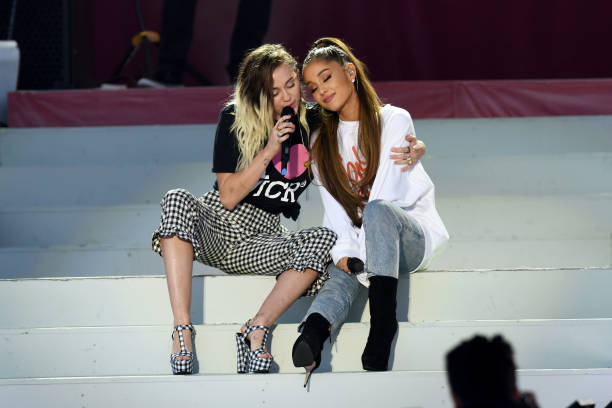
Miller (born Malcolm McCormick) broke through to stardom as part of XXL magazine’s 2011 Freshman Class, which also featured Kendrick Lamar and Big K.R.I.T. Miller’s first interaction with Grande happened on Twitter, in a 2012 thread about the Macy’s Thanksgiving Day parade, where he openly requested a collaboration. Eventually the two featured on tracks together, most notably on Grande’s Yours Truly lead single “My Way,” complete with a music video featuring a flirtatious kiss. (Grande later rated the kiss a 1/10 “because of the cigarettes.”) Grande and Miller eventually confirmed their relationship at MTV’s 2016 Video Music Awards, and on Instagram thereafter; Miller also was photographed comforting Grande upon her return from the Manchester attack.
This relationship, and its May 2018 dissolution, factored significantly into both performers’ art. Besides the numerous features each contributed to the other’s work, Miller in particular channeled their breakup as inspiration for the growth he demonstrated on his final record, 2018’s Swimming. Miller’s art, of course, also centered around his struggles from substance abuse. While he had achieved sobriety upon his romance with Grande, the tenuousness of that sobriety rendered their relationship dysfunctional, although the two remained close friends.
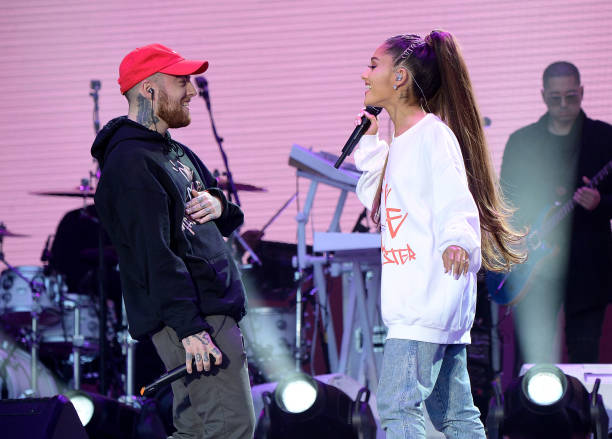
Two weeks after the end of her time with Miller, Grande started a new romance with Davidson, a comedian then known primarily for being one of the youngest-ever members of the SNL cast. Throughout the following two months, social media buzzed with speculation about the details of the relationship, details that both Grande and Davidson drip-fed from their own platforms. Grande also named a Sweetener interlude after Davidson, a decision she later defended on Instagram. The immediacy and intensity of their relationship, including the bewildering rapidity of its escalation into full-on marriage plans, guaranteed that she remained a dominant topic in pop culture. Every detail, every tossed-off comment or new tattoo, added kindling to the fire.
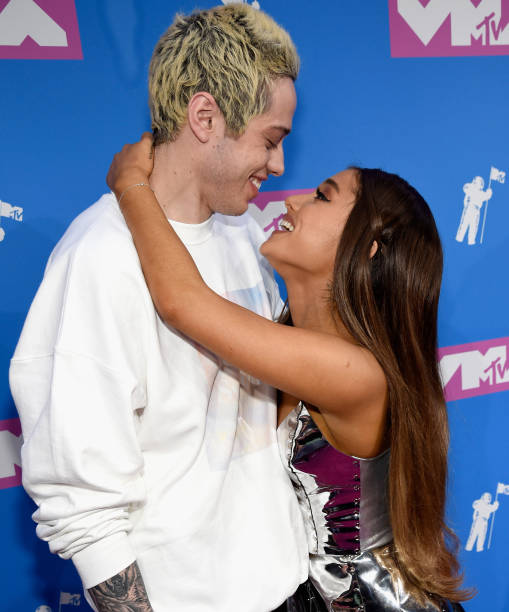
Then the fire burned out of control. On Sept. 7, 2018, Miller’s personal assistant found the rapper dead in his home studio from an overdose of fentanyl-laced Oxycodone. His death sent Grande into a spiral of grief that, according to a 2020 interview with Davidson, also sabotaged her relationship with him; the pair broke off their engagement weeks after Miller’s passing.
Miller’s death capped 18 months of trauma that started with the Manchester bombing, and Grande’s capacity to cope while in the public eye had reached its limit. The forces of social media, which she had leveraged to enormous financial and cultural benefit, now conspired against her: several Instagram posts and tweets from her now-deleted Twitter illustrate her frustration with social’s toxic mechanics. With studio time already booked to record her Sweetener follow-up, Grande called on close friends and familiar collaborators, retreated to New York, and began the process of recording thank u, next, the record that gave her the biggest hit of her career.
Though thank u, next features several songwriters and producers, including Max Martin and Tommy Brown (aka TBHits), longtime friends Victoria Monet and Tayla Parx are most responsible for helping Grande write the title track. Grande revealed in an interview that she and Monet, a frequent collaborator since Yours Truly, invented the phrase “thank u, next” during the course of their friendship; Monet later invited to the sessions Parx, who had previously contributed to the title track on My Everything, and together, with the help of countless bottles of Veuve Clicquot champagne, the trio fine-tuned the song Grande began writing during her engagement with Davidson — a song that underwent multiple lyrical changes given the tumult of their relationship.
Conceptually, “thank u, next” is like a time-released firework — one big blast, and then a shower of colors that burns into your retinas. Its meteoric impact comes from its voyeuristically detailing of Grande’s past relationships. “thank u, next” opens with a litany of them, including rapper Big Sean and footballer Ricky Alvarez, and small but tantalizing specificities abound, like her failed engagement to Davidson (“Even almost got married/And for Pete I’m so thankful”) and the subtle grief embedded in Miller’s couplet (“Wish I could say thank you to Malcolm/’Cause he was an angel”). Grande initially expressed hesitation about including these lines, but after Parx intervened, she recognized the power of the original version, power that in part comes from the song’s relatability: “thank u, next” brings the superstar to the same earthbound level as her fans, while nurturing their parasocial dynamic.
Yet if the first part of the “thank u, next” verse is meant to hook curious listeners with celebrity intrigue, the next part grounds that intrigue in intrapersonal terms. As the song’s synth twinkles and rubbery bass waxes and wanes, Grande fixates the spotlight back on herself and delves into how those relationships changed her for the better. “One taught me love/One taught me patience/One taught me pain,” she catalogs before concluding, “Now I’m so amazing.”
In the historical context of breakup songs, it’s a radical statement. We’ve seen “self-empowerment” before, but too often, that quality tends to arrive via tipping the scales: some of the most enduring breakup songs, like Gloria Gaynor’s “I Will Survive” to Beyoncé’s “Irreplaceable,” find solace in heartbreak by portraying the other party as a betrayer or a villain. Through this compensation, they become songs designed for the peak of discomfort brought on by heartbreak. “thank u, next,” in comparison, finds Grande at the final stage of grief, fully accepting the circumstances and willing to acknowledge how the experience strengthened her as a person.
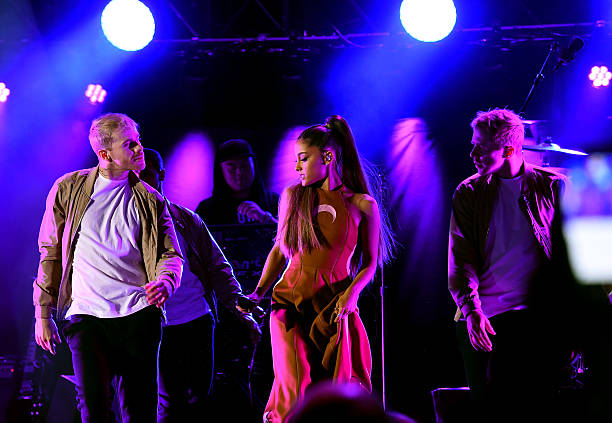
What makes “thank u, next” so brilliant in this respect is how it consciously uses the breakup trope as a Trojan horse to deliver its true message, its title a vessel for that notion. Without listening to the song, one might expect a title and chorus like “thank u, next” to deliver a sarcastic kiss-off, but it’s far more genuine than that — an altogether healthier and more resilient form of self-empowerment that feels necessary considering it lives in the realm of popular music, an arena populated by impressionable young listeners learning how to navigate their first relationships.
“thank u, next” is also wrapped in an engaging musical package. The instrumental meat of the song comes courtesy of producer TBHits along with duo Michael Foster and Charles “Scootie” Anderson, who go by Social House. Together, they created a backdrop that plays off the kind of kinetics Grande made her signature, but the tone is much softer, the dynamic more free-flowing than fiery. Foster’s opening synth notes, rounded and bright like a bokeh filter, introduce the chord structure, a simple rotation of four seventh chords anchored by a query (the third chord, B♭m7) and a resolution (the final chord, D♭7). The conversation between those chords insinuates constant introspection, and even though most of the chords are in a comforting major, the subtle dissonance of each additional seventh note hints at the friction that comes with growth.
Vocally, Grande can lay down multi-octave pyrotechnics akin to her idols Carey and Houston, but in keeping with the introspective tone of “thank u, next,” she tempers both her range and her volume. Still, her melodies constantly climb up and down the scale, and she introduces each chorus with a cascade of melisma. Grande’s lead vocal performance — which, if isolated, is revealed to be cloaked in thick reverb — jells with her and Monet’s backing vocals, and even though the biggest lyrical bombs are dropped right at the beginning of “thank u, next,” the song still gains momentum in each additional harmony.
The remaining rhythm section smartly buttresses the song’s sense of uplift. Its cushion of bass is a combination of Social House’s keyboard (which slides up and then down across each note like a bell curve) and Scootie’s deep, blocky 808s. The percussion is also built from two distinct sources: a mille-feuille of electronic drum loops and a series of compiled samples that Social House recorded live in the studio. Upon isolating the sample track, you can even hear Foster and Scootie’s voices yelping amid the beat. Finally, there’s the second set of chords underneath the main progression, which provide a syncopation that fleshes out the spaces the drum programming and samples don’t touch. Together, the team builds a track that perfectly encapsulates Grande’s sense of triumph in conquering heartbreak — or at least in accepting its transformative power.
When Grande surprise-released “thank u, next” as a single on Nov. 3, 2018, listeners devoured it. The song smashed several Spotify streaming records, and for the first time in her career, Grande debuted on the top of the Billboard charts, staying there for two months. The accompanying “thank u, next” music video, released at the end of November, fittingly parodied Hollywood cult comedies like Legally Blonde and Mean Girls, complete with a bevy of celebrity cameos; the clip broke viewing records on YouTube, and co-star Jennifer Coolidge (later to win an Emmy for her work in HBO’s The White Lotus) credited her appearance for single handedly revitalizing her acting career.
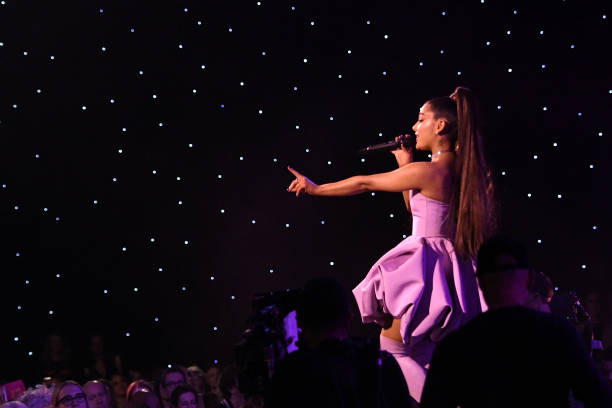
“thank u, next” also resonated with critics, placing high on 2018 year-end lists by Billboard, TIME, Pitchfork and NPR. A year later, several outlets included the song in discussions on music that defined the 2010s. “There has never been a song like ‘thank u, next,’” wrote Insider in a 2022 ranking of the century’s best breakup songs, “one that casually name-drops a superstar’s exes — not for shade or shock value, but to celebrate radical honesty and resilience, even in the face of unimaginable loss.”
But even outside of its torrid context, “thank u, next” simply does what all interesting pop does, playing on its audience’s expectations all while delivering a tune as appropriate for gatherings as for solitary nights in separate bedrooms. “TBHits” Brown said it best: “My mom called me, sang the song, and put her exes in the place of everybody else on the song. That’s when I knew it was gonna be a hit.”
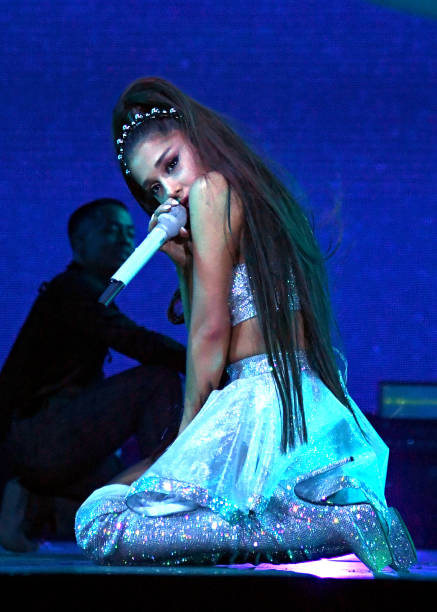
thank u, next (KORD-0023)

